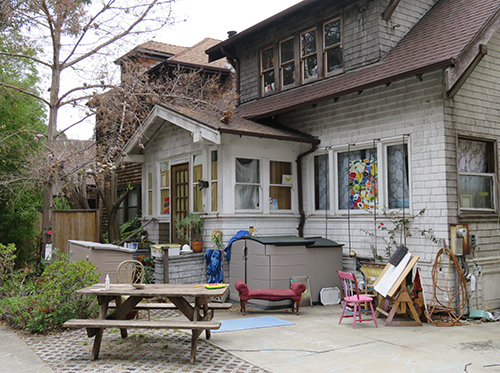Unclenching the Fist
It started Sunday night when the garage door broke, trapping my car inside. There was no choice but to wait around all Monday for a repair guy. I did, and he fixed the problem quite competently (and expensively!) while I wrote essay 1020 on 悦 (delighted, pleased, happy, joy).
It occurs to me only now what an irony that was because the longer I stayed cooped up at home (not at my office, near the heart of a lively city), the less joy I felt. How did I ever work at home for 10 years before renting an office? I felt so restless on Monday that the only way I could keep myself at my computer was to prepare a foot bath for under the desk (which is a no-no in drought-ridden California, so that needs to be our secret).
The pent-up feeling didn't leave, even when I could. It turned into a feeling of blahness that lingered for two days until I knew what I had to do: walk to work on Wednesday. The office is just 50 minutes away on foot, but I extended the route by 10 minutes because I craved the Indian Trail, a path that Native Americans created long ago. There's no pavement. Winding downhill between gorgeous houses, I jumped from one large flat stone to another, even passing a small cave. I don't know why, but it's exhilarating to walk that way.
I had chosen the perfect remedy, but not just because of the path. My dog Kanji also had something to do with my newfound joy. When we passed a terracotta lion planter, he doubled back to stare at it, refusing to budge (perhaps waiting until the lion moved first). Kanji's fur went up, head to tail, and when I finally managed to drag him away, he kept glancing over his shoulders to make sure his new enemy wasn't in hot pursuit.
We passed brilliantly colored bougainvillea, radiant morning glory, Japanese maples with a hint of autumn on their leaves, and a burbling creek (still full despite the drought!), as well as cottages tucked in the backs of properties, all of it quintessentially Berkeley. And then we came to the Berkeleyest thing of all—this front yard:

Photo Credit: Eve Kushner
What's going on—or rather, what's NOT going on? There's so much happening that it's hard to suss it all out:

Photo Credit: Eve Kushner
Do I see multiple images of Curious George in the window above the periodic table? And what's with the elegant (if dated) furniture out there amid the easel and the children's chairs and the finished artwork?
And how exactly does one enter this house?

Photo Credit: Eve Kushner
Or is it a house at all? Could it have become a day care center?
Or ... do they sell handbags in there?

Photo Credit: Eve Kushner
You may be wondering why I'm telling you any of this! Well, as it turns out, there's Japanese content in the display! Are you surprised?!
First, we have these multilingual package inserts on a rock near the sidewalk (with nothing to prevent the papers from flying away, as far as I can tell):

Photo Credit: Eve Kushner
They explain the design of a brocade by Tatsumura Textile Co.:
円文白虎朱雀錦
Tiger and Bird Brocade
円文 (えんもん: round design); 白虎 (びゃっこ: White Tiger, a god said to rule over the western heavens); 朱雀 (すざく: Vermilion Bird, a god said to rule over the southern heavens); 錦 (にしき: brocade)
A few comments:
• A brocade is a fabric woven with an elaborate design.
• You may associate 文 with writing or with characters, but it can also mean "pattern," as in 文様 (もんよう: pattern) or 斑文 (はんもん: speckles; spotted pattern). In fact, Henshall says that 文 (or rather its earlier shape) originally depicted a "beautifully or intricately patterned overlaid collar" and can still mean "stripe" or "pattern" in Chinese. Eventually, "intricate pattern" extended to "writing" as a definition.
• The non-Joyo 雀 means "sparrow."
I wish the brocade had been part of the display, but perhaps that's asking for too much! You can actually see an image of this piece at the Tatsumura Textile site, where the furigana indicate that the yomi of 朱雀 is すざく. Oddly, the English insert has an alternate reading in romaji, Sujaku.
Here's a closeup of those inserts:

Photo Credit: Eve Kushner

Photo Credit: Eve Kushner
Beneath a butterfly-shaped light (?) fixture perched on a tree, a bilingual calendar offers another juicy treat!

Photo Credit: Eve Kushner
Here's what it says:
握れば拳
If you clench (your hand), you have a fist
握る (にぎる: to clench, grip); 拳 (こぶし: fist)
開けば掌
If you open (your hand), you have a palm
開ける (ひらける: to open); 掌 (てのひら: palm)
Ah, I just blogged about 開! And how appropriate it is after my mood-shifting walk that, as the translation on the calendar awkwardly says, "Even if it's the same thing, one's viewpoint can make it different." Indeed!
You can read Japanese analyses of this saying in various places:
They all explain that just as one can use one's hand for different purposes, depending on the shape, one can use an item such as a kitchen knife either to cook or to stab someone! The choice is yours!
Yesterday brought the first essay publication in three weeks! Check out this sneak preview:

Have a great weekend! And, if you're up to it, drag your most interesting possessions into your front yard to serve as conversation starters for your neighbors!

Comments